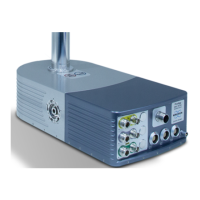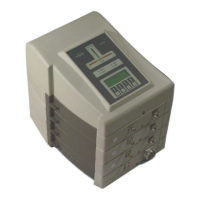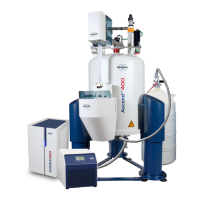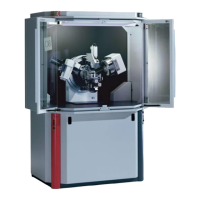60 (107) BRUKER CryoProbe User Manual
Recommended NMR parameters
decoupling periods!). COOL DOWN will flash three times quickly, acknowledging the
cool-down request. Usually, the system should be ready again within 15 minutes.
Receiver setting 5.6
0
The effective digitizer resolution dr should be 18 bit or more to keep quantization
noise at a negligible level. Use a small sweep width swh for your particular exper-
iment.
Do not employ an automatic receiver gain adjustment rga because it typically
uses only about 50% of the available ADC range. To find the optimum receiver
gain rg, increase the sweep width swh such that the dynamic range dr is still the
same as in your particular experiment. Increasing swh assures that there are no
strong signals outside the digital filter width. Adjust rg so that more than 80% of
the ADC’s effective range is used, e.g. at least 100 000 units on the y-axis
in the FID display window acqu if the effective digitizer resolution is dr = 18. After
having determined the optimum rg change swh back to its original value and pro-
ceed with your experiment.
For small receiver gain values, i.e. rg < ~256, the signal-to-noise tends to de-
crease in proportion to rg. If the CryoProbe is always used with samples that
yield a strong NMR signal like an H
2
O solution, a permanent reduction of the
overall receiver gain may be beneficial because this decreases also the noise
added inside the receiver. The modification is a jumper setting in the RX22,
ECL07 or higher. As a consequence, rg values will be higher than before by
about 12 dB for all measurements.
CAUTION: Do not try to change the jumper settings on the highly sensitive RX22
board on your own. It is recommended that you have a B
RUKER service engineer
carry out this modification upon installation of your CryoProbe.
Shimming 5.7
0
Gradient shimming 5.7.1
Make sure to have F
IELD adjusted such that the lock wiggles are centered in the
lock window to avoid H
0
offsets between gradient shimming and lock-in operation.
If an A
CUSTAR is used, check its DC offset adjustment by observing the lock level
while pressing its Z R
ESET button.
H
2
O samples 5.7.2
A temperature gradient inside the sample solution can spoil the resolution even if
the shim and the water suppression are excellent. The most prominent tempera-
ture gradient is linear along the z-axis. Since the position of the water resonance
is temperature-dependent, a linear resonance shift along the z-axis would result.
When shimming with D
2
O using the lock level, one would balance the tempera-
ture shift of the water resonance with the z-shim because this would superimpose
the water signals from different regions of the sample and thus increase the lock
2
dr 1–

